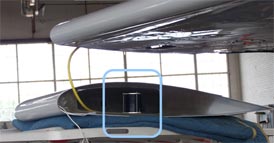Multifilter Radiometer Added to Cessna Payload
Published: 31 July 2007

Downward-facing multifilter radiometers (MFR) are instruments used to measure the intensity and distribution of reflected energy from different surfaces, such as grass or dirt. The relative amount of reflected energy—also called “surface spectral albedo”—is important for determining the amount of energy exchanged between the surface and atmosphere in a given location. In May, an MFR was added to the instrument payload on the Cessna 206, which acquires routine in-situ aerosol profiles and carbon measurements at the ARM Southern Great Plains (SGP) site.
Historically at the SGP site, surface spectral albedo measurements were only possible using downward facing MFRs positioned at the 25-m level of the 60-m tower in a wheat field at the SGP Central Facility, and on a 10-m tower in the adjoining pasture. This limited spatial coverage resulted in a very narrow dataset. The addition of an MFR to the Cessna payload allows routine measurements of surface spectral albedo over a much broader area around the SGP Central Facility.
Modification to the Cessna required new wing-tip extenders and rewiring for the data acquisition system. Installation of the new larger wingtips took place in Wichita, Kansas, with modification of the starboard wingtip to accommodate the MFR. The plane was then flown back to its field base in Ponca City for installation of the MFR instrument.
The ARM Climate Research Facility is a DOE Office of Science user facility. The ARM Facility is operated by nine DOE national laboratories, including .
Keep up with the Atmospheric Observer
Updates on ARM news, events, and opportunities delivered to your inbox
ARM User Profile
ARM welcomes users from all institutions and nations. A free ARM user account is needed to access ARM data.


















